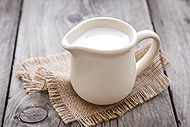
Keep your eye out for these nutritious fruits and vegetables as they hit their peak during the spring growing season.
Asparagus
Asparagus contains a prebiotic called inulin that aids digestive health by promoting the growth of good bacteria. It is also loaded with anti-inflammatory phytonutrients, and vitamins and minerals that act as antioxidants.
Cooking tip: Place 1 pound of asparagus in a single layer on a baking sheet. Drizzle with olive oil and sprinkle with salt and pepper. Broil on low for 10 minutes. Serve warm.
Artichokes
Artichokes provide folate, fiber, vitamin C, and vitamin K. They contain the disease-fighting flavonoids quercetin and anthocyanins. Artichokes are a source of lutein, which promotes heart health, and cynarin and silymarin, which have been linked to liver health.
Cooking tip: Cut off the stem of a fresh artichoke and remove the outer leaves. Cut off the top and trim any spiked points on the remaining leaves. Steam the artichoke for 20 to 30 minutes. Enjoy the tender, fleshy part of the leaves with your favorite dip. Chop up the artichoke heart and use it as a pizza or salad topping.
Beets
Beets contain fiber, potassium, and folate. Purple and red varieties also contain betacyanin, a phytochemical found to protect against cancer and reduce the inflammation linked to heart disease.
Cooking tip: Trim the stems of five or six small beets and scrub them clean. Drizzle them with olive oil and wrap them in aluminum foil, creating a packet. Roast for 25-35 minutes at 400 degrees Fahrenheit, or until the beets are tender. Slice and serve on a fresh, green salad with goat cheese.
Garlic Scapes
Garlic scapes grow from a garlic bulb to form a long green, curled stem above the ground. Like garlic, the scapes are part of the allium vegetable family. These foods contain sulfur compounds that act as antioxidants to fight disease.
Cooking tip: Thinly slice garlic scapes and use them in any dish you would use scallions. Toss them into stir-fry or noodle dishes, and add them to omelets or quiche. They can also be blended into basil pesto.
Peas
Spring peas provide manganese, folic acid, fiber, and vitamin B6. They have been recognized as a source of alpha-linolenic acid, a type of omega-3 fatty acid. Peas also contain coumestrol, a phytochemical that has been linked to a reduced risk for stomach cancer.
Cooking tip: Sweet spring peas can be eaten raw as a salad topping. They can also be steamed until soft and mashed like potatoes.
Radishes
Like kale and Brussels sprouts, radishes belong to the family of cruciferous vegetables. These foods contain glucosinolates, which have been found to protect against cancer. Radishes are also a source of vitamin C and fiber.
Cooking tip: Serve quartered radishes with fresh green salads, thinly slice them to use as a sandwich topping, or dice them and add to coleslaw.
Spinach
This leafy green is a source of vitamin C and vitamin K. It provides the carotenoids beta-carotene, lutein, and zeaxanthin, which act as antioxidants and also promote healthy vision. Spinach has been found to protect against aggressive forms of prostate cancer.
Cooking tip: Gently saute 2 cups of spinach in a skillet with 1 teaspoon of olive oil for 2 to 3 minutes. Season with your favorite herbs and spices and eat as a side dish, or add it to lasagna, quiche, or cooked grains like quinoa.
Strawberries
Strawberries provide vitamin C, folate, and fiber. They contain over 18 phytonutrients, which have been linked to the prevention of cardiovascular disease and cancers. Strawberries have also been found to aid in blood sugar control.
Cooking tip: Make a fruit salsa with ½ cup each of chopped strawberries, chopped pineapple, and chopped kiwi. Stir in 1 teaspoon of finely chopped fresh mint. Enjoy with cinnamon pita chips.
Sources



 3 Healthy Lunches for Your Work Week
3 Healthy Lunches for Your Work Week
 5 Tips for Stretching Your Budget for Healthy Food
5 Tips for Stretching Your Budget for Healthy Food
 Best Ways to Reduce Added Sugar
Best Ways to Reduce Added Sugar
 Healthy Tips to Lighten Up Picnic Foods
Healthy Tips to Lighten Up Picnic Foods
 Do You Need to Drink Milk?
Do You Need to Drink Milk?
 Tips to Keep Track of Water Intake
Tips to Keep Track of Water Intake
 Butter vs. Margarine: What’s the Best Choice?
Butter vs. Margarine: What’s the Best Choice?
 7 Good Mood Foods
7 Good Mood Foods

 Pinterest
Pinterest RSS Feed
RSS Feed